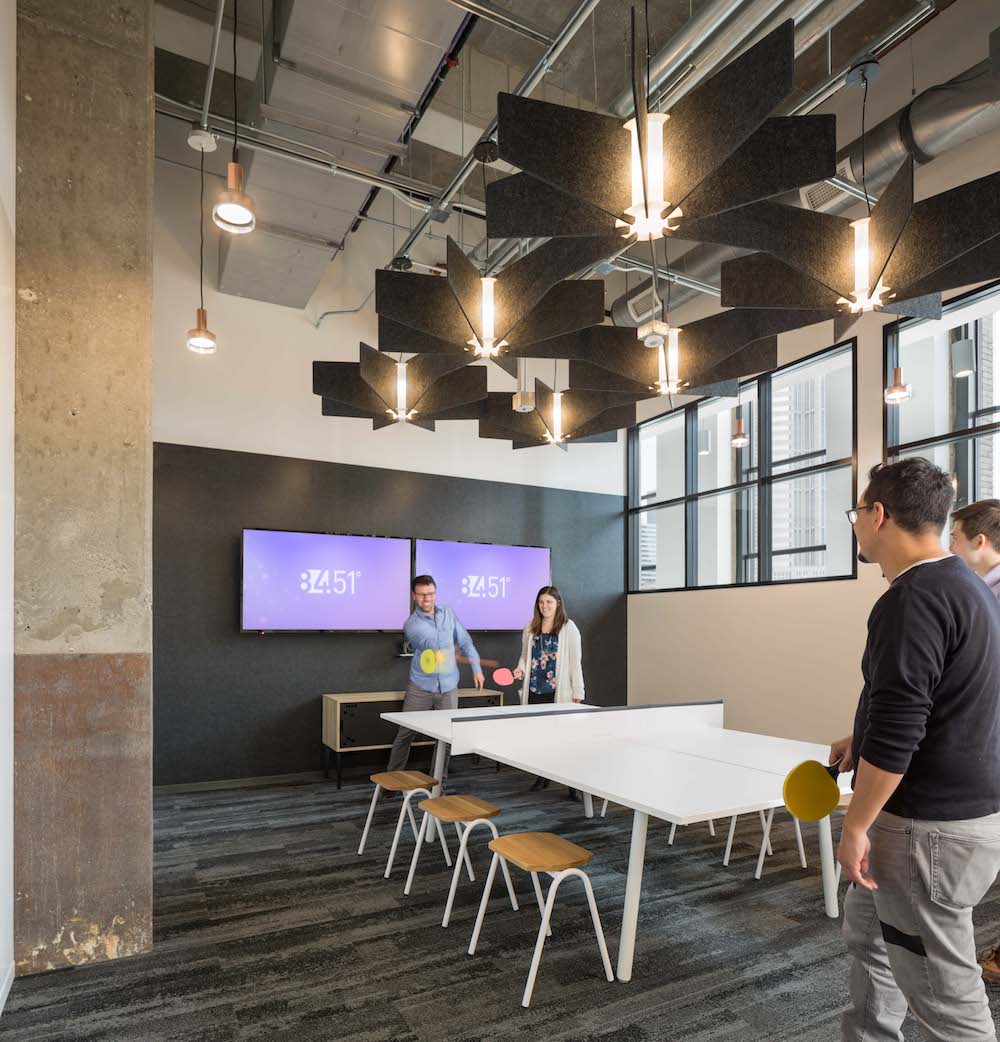BHDP shares the eight primal needs for companies to consider as we make our return to the workplace.
With companies preparing to provide employees with a workplace re-immersion experience that drives engagement and is authentic to their corporate culture, it’s a good time to re-evaluate the workplace and understand what will motivate the returning workforce. Workplace design, now more than ever, is at the heart of a successful re-entry into the office. Leveraging what experts know about human behavior and neuroscience, designers and workplace professionals can help ensure that employees feel that their subconscious, primal needs are being considered so that they can get to work and contribute rather than be bogged down with stress and anxiety.

Eight primal needs
Human beings are born with eight primal needs—needs that are programmed by DNA into the subconscious—and are essential for survival. These eight primal needs are acceptance, connectedness, contentment, freedom, gratification, guardianship, prestige, and survival. Many of these needs have been described by the work done in neuromarketing (consumer neuroscience) during the last decade. These eight primal needs are managed by the subconscious brain. The subconscious brain manages 95 percent of people’s daily lives, decisions, and behaviors. Most people are not consciously aware of these eight needs and have no control over them. Rather, they serve as the subconscious reasons why people do what they do.
These eight primal needs subconsciously drive human actions with the end goal of seeking fulfillment and survival. An inspiring workplace design can tap into these primal needs and positively foster connectedness and acceptance. Design that does not keep the user as its primary focus can trigger a negative impression and possibly elevate discomfort or stress. A workplace can be designed to strengthen a person’s sense of safety and sense of belonging. In addition, space design that helps foster these feelings can reap rewards in productivity and satisfaction, as well as reducing turnover. That is why they are important considerations for companies when restaffing the workplace.
The future of the workplace
Significant deficits in meeting these primal needs in the workplace have accrued in the last 16 months. How individuals connect with others has gravely suffered. Viktor E. Frankl, the neurologist and Holocaust survivor, says that man can endure suffering “on the condition that his suffering has meaning.” Human beings can endure a lot, but without making these connections to the eight primal needs, they deprive themselves not only of purpose but also the ability to generate neurotransmitters like oxytocin, serotonin, and dopamine, normally generated by simple human interactions and an integral part of keeping people mentally balanced and happy based on the story they are telling themselves about their own lives.
Human brains are designed for stories. They have a mechanism called the Default Mode Network—a network comprised of different parts of the brain working together—and this mechanism is fed by stories, particularly the story of one’s own purpose. When people feel that their purpose is diminished, it affects their ability to display empathy, altruism, and reciprocity.

Today, there are three types of workers to consider in the new workplace. Workers who have lost their jobs and are now returning; workers who have been working remotely, and those who have been on the front lines as essential workers. When these workers come together again the concept of re-immersion will need to be addressed. Employees will be faced with the need to re-learn social norms, shaking hands and giving hugs instead of fist and elbow bumps. Forward-thinking companies will want to train their managers to be empathetic to the needs of the returning workforce.
One of the primary responsibilities for managers is to focus on reducing anxiety and identifying fear. The primary difference between anxiety and fear is that fear has a fear object. Anxiety is worry without knowing what one is worried about, whereas fear is worry about something specific. To be successful, managers should bring their staff into the conversation so that they can help identify these fear objects and transform their anxieties into fears that can then be addressed.
The role of change management
Change management also has a role to play in this process. By focusing on adoption, acceptance, and understanding of the space, they can communicate that these eight primal needs are being addressed. This in turn will send neurons firing back through the subconscious part of the brain that everything is ok. One of the common tools is a short (three to four question) pulse survey. This can provide some explicit employee attitudes, though managers will need to elevate their Emotional Quotient (EQ) in relating to their employees.
That said, other ways transcend the impact of a survey or corporate email. Gamification is one approach, where managers engage workers on a more pleasurable level. One study, conducted by Dr. Dustin Jackson for a government agency, found that only 13 percent of their employees read internal communications from upper management. Notably, this 13 percent also serves the function of the rumor mill within the company, which is desirable if the message is positive.
Another method for facilitating change management is by creating pilot programs, where selected employees can influence decisions made about returning to the workspace. These pilots can provide invaluable metrics for how effective any change can be to the work environment. The people chosen are an important component for success. Often employees who react negatively to change can be sources of the most useful actionable criticism, which helps improve the company’s initiatives. It is also important to be honest about the results. Management can find solace in the Pratfall Effect, the principle that even mistakes can, in fact, endear them to their employees. When management is confident enough to show some vulnerability, employees are known to respond better and more favorably.

The role of UX and WX in addressing primal needs
Microsoft Corporation’s recently released Work-Trend Index study of global workers revealed that of the 30,000 polled, 41 percent were considering leaving their jobs. To create a successful workplace experience, a renewed focus must be placed on whether it is 1) viable, 2) feasible, and 3) desirable. No matter what kind of changes organizations make to their physical space; ultimately, if employees can experience a feeling of delight or pleasant surprise upon returning to the workspace, it will have a more profound impact on employee engagement. Employees coming back will want to know what has changed. They will want to see the organization being authentic and working hard to drive their culture. The culture of the organization lives in its space. Those organizations who can get this right will drive innovation and create more revenue and shareholder value.
Empathetic designers will recognize, incorporate, and address the eight primal needs in their designs. Knowing how colors, shapes, and branding impact these needs can help impart a certain level of flexibility and control to the employee. Options should be provided for an increased sense of safety or to include workspace opportunities that would promote connectedness, acceptance, or prestige.
Practical tips
At the neurological level, people are tribal-based creatures of habit. Even if teams are remote, it is important to make them feel part of the tribe. Think about how a marketer might build tribal identity. They would use mascots, taglines, slogans, logos, and merchandise. These items help make workers feel close as a team, and that tribal kinship is what will help smooth the transition back into the workplace.
When thinking about day-to-day in-office experiences, one company mandated managers to keep meetings under 50 minutes, since studies have shown this is about the length most humans can endure before they require a break in attention span. It is also important to go beyond group Zoom meetings and reach out to employees individually and find out whether their primal needs are being met. In addition, it is important for management to strive to be creative with how they engage with clients or employees. Walking meetings have been in vogue for decades, and there are other ways to promote well-being while increasing the blood flow required for heightened brain activity.
These eight primal, subconscious needs—acceptance, connectedness, contentment, freedom, gratification, guardianship, prestige, and survival—can serve as a springboard when considering workplace design challenges and solutions. Organizations that take the time to learn how the eight primal needs affect the way employees feel about their work and their workplace are in a better position to sculpt an ideal workplace environment and corporate culture. When they learn how to address these innately human demands and transform them into actionable items, they can reduce discomfort and even breathe excitement and wonder into the workspace. By looking at workplace design changes through the lens of these eight primal needs, organizations can use these neurological responses to supercharge their workforce and maintain their competitive advantage.

